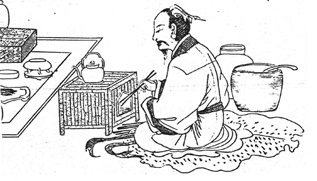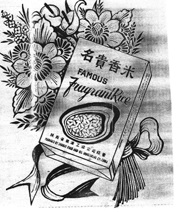
| What is Flavor and Fortune? |
| How do I subscribe? |
| How do I get past issues? |
| How do I advertise? |
| How do I contact the editor? |
Read 13198178 times
Connect me to:
| Home |
| Articles |
| Book reviews |
| Letters to the Editor |
| Newmans News and Notes |
| Recipes |
| Restaurant reviews |
| Article Index (all years, slow) |
| List of Article Years |
| Article Index (2026) |
| Article Index (last 2 years) |
| Things others say |
| Related Links |
| Log In... |
| Authors |
| Categories & Topics |
TOPICS INCLUDE: Bubble tea, Han Murals, Tea, Oysters, Sticky Rice
| by Jacqueline M. Newman |
Letters to the Editor
Spring Volume: 2018 Issue: 25(1) pages: 5 to 7
From Maille in Midtown:
Loved the picture on the cover of bubble tea, but why
no information about this beverage in that issue?
Maille: Thanks for calling us to task; shame on our not
seeing that what we wrote about this tea was not included.
Bubble tea was first introduced in Taiwan in the 1980s by
three guys who also popularized it. Their names were Liu
Han Chieh, Lin Hsui Hui, and Tu Tsong He. In this great
beverage are balls used in many different flavored and
colored drinks, hot and cold. They are popular and loved
by the young and the young at heart. They are usually
black and made of ground Manihot esculenta, better
known by various names including manioc, cassava, or
yucca. We were told they (not sure if the balls or the
guys) came from the Phillippines, are dried, ground, and
gray. After boiling, they turn black and translucent. And
in one hour they look gelatinous. Newer ones now come
in various colors. Commonly served in black or green
tea but they can be in any other beverage, and often with
condensed milk and flavorings. Their popularity is such
that some call it McBubble. Others simply say ‘tapioca
tea’ which in Chinese they say: zhen shu nai cai. This
beverage when cold is most often served in clear dometopped
plastic containers, the bubbles resting on the
bottom. With a fat plastic straw poking through the hole
on the dome-topped lid, big enough for those bubbles
to be sucked up through the hole. We love our bubble
tea with lizhi-flavored syrup or peach syrup, also pear,
papaya, or yin-yang (that is half coffee half tea). This
latter mixture is very popular in Taiwan, a flavor combo
making its way to other countries.
Ling Ling asks:
Can you share one or more Han murals with us?
Ling Ling:
We have seen pictures but are not allowed
to print them. Here is what we saw in one from a tomb in
Henan excavated in 1960 it was a kitchen scene showing
folks working there, one was stirring meat in a ting or
caulron, one carrying firewood, one with a dish of fish, two
carrying a large pot or keng, one chap drawing water from
a well, another holding a basin for this water. Also, there
were two kinds of meat hanging in the upper left corner.
We could not identify them.

Editor from Ed:
Some of your recent issues delve into the past. As an
eighteen-year-old avid tea drinker, can you look back
and tell me and others about teas in the past?
Ed: I was just about to pitch a batch of early tea
information including one from the 1898 Original Boston
Cooking School’s Fannie Merritt Farmer Cook Book that
erroneously says “Orange Pekoe and Flowery Pekoe
are made from the youngest leaves.” Clearly, she could
not read our recent article ’‘Tea is Tea-rriffic’ in the last
issue advising that pekoe and orange pekoe are tea leaf
sizes “neither the smallest nor close to the largest.”
Not all old tea information is correct. In an 1845 volume
called: Midshipman in China, they mention bird’s nests
correctly but do not have correct tea clarifications; nor
does the New Household Receipt-Book written more
than a hundred years ago. This book’s sub-title says
“maxims, directions, and specifics” and talks about
names of different teas gathered, even peculiarities in
their manufacture, but nothing about these two tea-size
names. It is not always right to describe ‘black tea as
Chinese large tea’ (and) ‘souchong as small scarce sort
pekoe.’ This book says ‘young hyson is gathered early
in the season, hyson-skin the refuse or inferior portion’
which is also not correct. An 1859 book titled Breakfast,
Dinner, and Tea writes about a tea recipe, saying its
“ingredients are ‘boiled down to a perfect mush,” and
that “rat soup is considered equal to ox-tail” but nothing
about tea worth knowing is. We do not believe words or
pictures including their early line-drawing of a wooden
box with fire in it heating a tea pot. Why is the box not
burning?
From Lizee:
I know little about; oysters in the Chinese cuisine; can
you add to that?
Lizee: Oysters can be cultivated or simply raked and
collected. These bivalves were once valued as aphrodisiacs
and for their pearls. Now they are loved for their pristine
sea-worthy taste. Most are found in brackish water, can
be up to ten inches wide or long. Years back many were
used to make oyster sauce, today they are loved raw,
cooked, or bottled as sauce. In the past, more were dried
or partially dried, and made into oyster sauce that was
salted, rinsed many times, and boiled often in fresh water.
These steps were repeated often, more oysters added,
their liquid reduced until brown and thick, then cooled,
bottled, sealed, then set aside for about a year before sale.
Also in the past, few Chinese ate raw oysters; now many
do, particularly young folk.

From Ted:
Some rice questions
including: What
makes rice sticky?
Is it always a short
grain and Japonica?
What are black and
purple rices; and how
should I cook them?
Ted: Most sticky
rice is short-grain rice
with high levels of
amylopectin and low
levels of amylose; both
common rice starches.
Sticky rice cooks up
drier than non-sticky rice; it should be rinsed well in cold
water before cooking. When cooked it does get stickier
and can feel tacky, can clump, also not be mushy. We
like ours with distinctly plump grains, and somewhat
chewy. For those never seeing black Rice, also known
as ‘Precious Rice,’ ‘Forbidden Rice,’ or ‘‘Fragrant Rice.’ It
was forbidden to common folk in ancient China. This
rice often turns dark purple when cooked, depending
upon which of the hundreds of varieties that exist. Some
have white interiors that get more tinted than others.
One dietitian told me that “the darker the exterior, the
more nutritious it is”, and she said that “Persian rice is
very nutrient dense.” As a dietitian myself, I have seen
different nutrient amounts in different sources, and do
not agree that “all black rice is basmati rice” as she said.
Maybe it is in her country, but not everywhere. We once
did read that since Emperor Wu of the Han Dynasty (206
BCE - 220 CE), rulers did seek out black rice and it was
given to them as ‘tribute rice.’ Forbidden to commoners, it
was often used as gifts for high officials, and in medicines
to nourish blood, kidneys, stomach, eyesight, and the
liver. On this topic, Zhang Qian, a diplomat once fell
asleep by a willow tree and when he awoke his dream
did instruct him to find some so he did search for it. An
early unknown artist did show him doing so. Later, it
was sold not as forbidden rice, but as fragrant rice as
seen on this page. A few recipes using it follow.
| Black Rice |
|---|
½ cup black rice
1. Bring rice and six cups water to a boil in a large
pot, cover the pan, and reduce the heat and simmer
until tender and almost all the water is absorbed
(about three-quarters of an hour) until the grains are
separated and cooled a bit.
|
| Noodle Sheets With Black Rice Flour |
|---|
½ cup black rice flour
1. Whisk black rice flour. cornstarch, and tapioca
flour, then add six cups of water slowly, another one if
needed, and allow to stand for an hour.
|
Editor, please:
Can you provide a recipe for a paste made with red
bean curd. We did have some in Xian; but can find
none in a Chinese market in New York nor in any book
here. Help.!
Nameless: Hope this meets the taste you
remember:
| Red Wine Paste |
|---|
1 Tablespoon mashed red bean curd
1. Mix all ingredients in a blender.
|
From Staten Island Aldo:
Advise about yum cha; is it always the same as dim
sum?
Aldo: Dim sum is Cantonese, yum cha its Northern
name, both are for their snack food served in large
places that can make a thousand or so varieties, only a
hundred or so on any given day. Usually served mornings
through lunch time, and from trays or rolling carts, their
contents called out by women, then brought to your
table. We never saw a man doing so, rarely found a
printed menu, either. The best time to go is about eleven
in the morning; and not after two p.m. Selections can
be very limited before or after those times. A favorite in
Hong Kong is the oldest known as Luk Yu at 24 Stanley
Street in the Central District.
From Liam in PA:
Thank you for your article about snakes. I have a
friend from Zhanghu in China in the Fujian Province
who worships them. She says her folks, now deceased,
said where they grew up they had a Snake Parade
Festival. She now lives in Pennsylvania and knows no
one to learn where that was.
Liam: For all who loves snakes, we think she means
the city with a three-day Snake Festival from the 16th to
19th day of the first lunar month, and a Snake Parade
on the 7th day of the 7th lunar month. For the latter
one, thousands parade and dance through the streets
with one or more snakes while other snake lovers open
their doors and welcome them in to see theirs. On the
former one, many make boxes that look like snakes,
flowers, birds, bugs, or something else, and attach them
to each other looking like a very long snake, then parade
around on the third night of the New Year to the Temple
of the Snake King. There, they get burned sending them
to heaven wishing for good luck in the coming New Year.
From Lee-Hwa:
Thanks for the article about the Allium family; any
advise for their microwaving?
Lee-hwa:
Re: Garlic: Put half cup peeled garlic cut as desired in a
glass bowl with half cup of vegetable oil. On 100% power,
cook them for five minutes, them stir well. Repeat with
100% power for two minutes, and stir again. If not
golden, keep repeating in two minute cycles; then season
with a little salt and/or confectioners’ sugar and serve.
Re: Shallots: Rinse, drain and cut up three shallots,
put them in a glass bowl with half cup of oil, then follow
instructions for garlic above, but in three then two
minute cycles.
Re: Leeks: Use white par of two leeks, cut lengthwise
them cut them in pieces to suit. Toss with two
tablespoons flour, and follow instructions as for garlic,
but in two minute cycles.
| Five Spice Powder |
|---|
1 Tablespoon whole cloves
Put in a blender. Grind until fine, stir well, and store in a small glass jar in a cool dark place. Then use as needed. |

Copyright © 1994-2026 by ISACC, all rights reserved
Address
3 Jefferson Ferry Drive
S. Setauket NY 11720